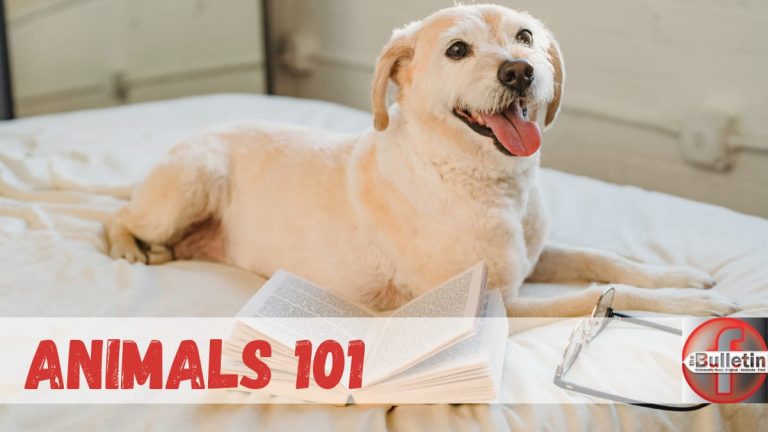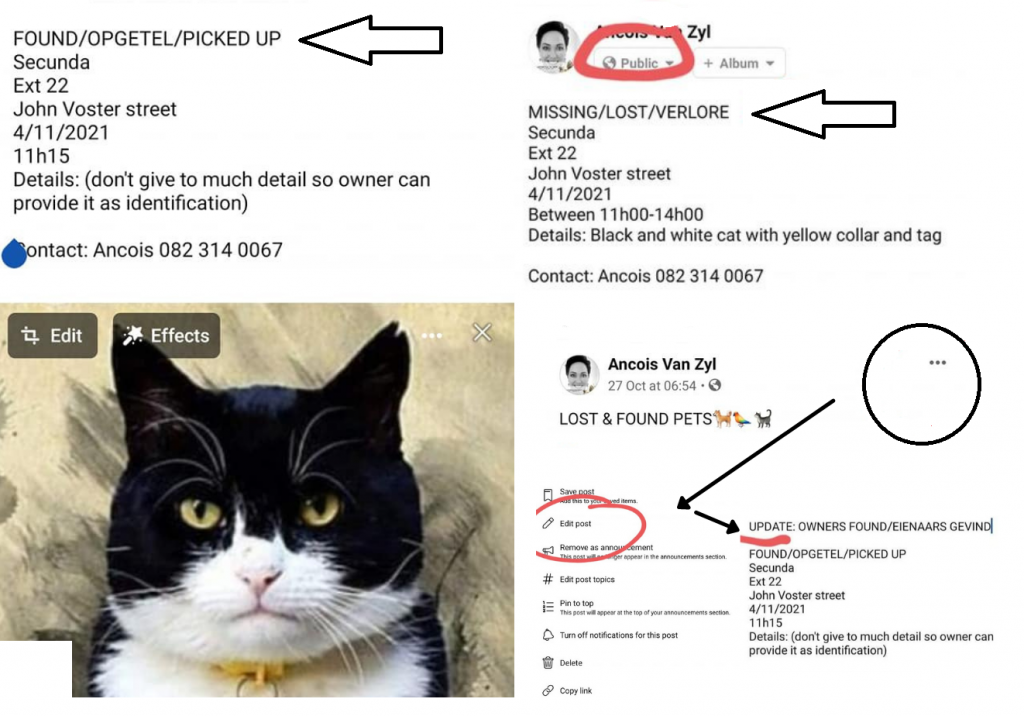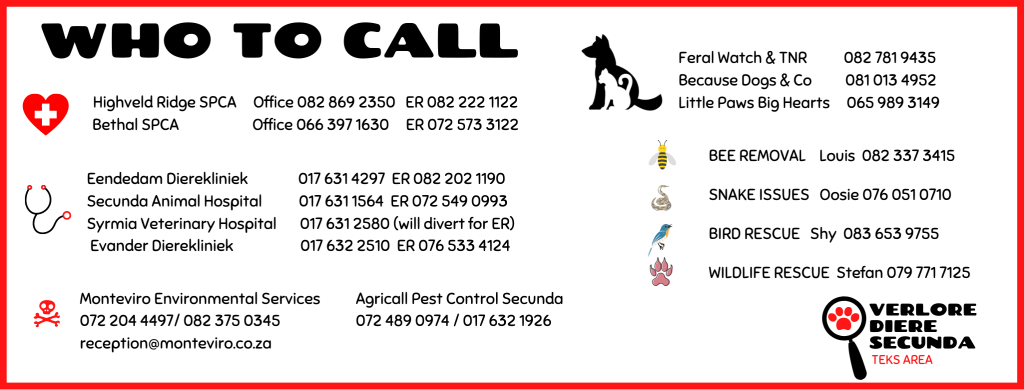
ANIMALS 101 – A GUIDE TO LOST AND FOUND ANIMALS IN AND AROUND SECUNDA.
Many animals are roaming the streets and reported as lost! This happens all year round, but we see especially high volumes during and after the holidays or firework displays. There are always good Samaritans who take them in and keep them safe, but many people do not know how to proceed, so here are our guidelines.
PREVENTION IS BETTER THAN CURE
- Escape-proof your yard. (Including for cats)
- Sterilise your pets which helps reduce roaming.
- Micro-chip them.
- Register the micro-chip on more than one database.
- Add a collar ID with your number on it (we don’t add the animals name for safety reasons)
- For cats a break-away collar with ID.
- Have a recent photo available.
- Get a responsible pet sitter when you are away.
- Know how and where to post.
JOIN YOUR LOCAL SOCIAL MEDIA GROUPS IN ADVANCE
IMPORTANT – Join the local WhatsApp group for lost and found pets, our VERLORE DIERE SECUNDA (TEKS) group on Facebook (not the page) and your neighbourhood watch groups. Others shared your lost pet’s post, please do that for them.
If you are not on the local WhatsApp group, contact Chantel on 081 013 4952. If you know someone who is not on social media, they can also contact Chantel, so she can post for them.
We try very hard to centralize this to more effectively reunite animals, but there are so many people, inexperienced in animal welfare, who do their own groups. This is not beneficial for an effective reunion of pets.
POST ON SOCIAL MEDIA PLATFORMS
Posting correctly is important to more effectively reunite pets and save time. Your post should include:
- Whether you found a pet or lost a pet.
- A photo.
- The area (street, near e.g., Spar & town).
- The date (lost or found).
- Estimate time if possible.
- Contact person & number. (Facebook Messenger is ineffective if you aren’t friends)
We don’t recommend adding too much info about the animal as that info can be used to “test” the owners who claim them.
Please COMMENT on and SHARE the original post only and always! Don’t create many different posts nor add details like a contact number in the comment section, as few people read it.
If you share it from your personal profile, make sure the setting is public, otherwise only your friends can see the post.
Frequently reshare the original post again.
UPDATE the original post as soon as the pet is found, so those who shared the post can see the outcome and people can rather share other lost/found posts instead of an already found one. How: click on the 3 dots in the top right corner of your original post. Choose “edit post” and then add above the original writing in capital letters UPDATE: OWNERS FOUND or BACKHOME, AT VET, AT SPCA etc.
The SPCA may not advertise the animal during the pound period, so continue to share the post that you updated with “at the SPCA”.
Look for our tags on the posts like #owneresfound etc.
EXAMPLE BELOW

YOU LOST A PET
- Phone your local SPCA and send them an email with picture & detailed description of your pet.
- Visit the SPCA frequently IN PERSON. Remember they have many animals coming in daily.
- Drive around in your area.
- Put up posters (good idea to have one in advance).
- Search manholes or other hiding spaces.
- Contact your local Vets to see if an animal has been brought in.
- Share on your local social media pages or groups as per social media guide above.
- Contact other local welfare organisations.
- Continue to follow up with the SPCA and other organisations.
- Try and call for pets at night as sound travels further.
- Some suggest putting out cats’s litter-box or pet’s blankets, as a familiar scent could help them find their way home. (Controversy about litter-box exists)
- Sometimes stolen animals are sold or dumped in nearby towns, so widen your search.
- If they have a micro-chip, immediately double-check if it is registered. Type in the micro-chip number on both ChipNDoodle and AMLA. If it does not appear on both, you can still do it immediately and it can help if they are found.
- Re-check areas previously searched.
- Don’t give up as some reunions even happened weeks, months or years later.

YOU FOUND OR SEE A STRAY ANIMAL
- If they are hurt, please take them to the local Vet or SPCA.
- Contact the SPCA emergency numbers if an animal is injured or in distress and you can’t help.
- Provide water, but be careful so that they don’t over-drink as well as be cautious with giving food.
- Scan for micro-chip at local vets, SPCA or animal welfare organisations (Feral Watch & TNR or Because Dogs & Co).
- Check with groomers if it seems like a recently groomed pet.
- If it appears that the animal has recently been to the vet (stitches, healing wound or vet shaved areas), please check with all local Vets.
- Post on local social media groups/pages.
- Take care of the animal (foster) until you find the owner.
- Find a foster home if you can’t foster and after 7 days organize adoption through one of the responsible welfare organisations.
- Take the animal to the SPCA if you can’t foster or find a foster. The SPCA has a 7-day pound period, after which the animal becomes their property and can go up for adoption or be euthanized. The owner claiming the animal will be responsible for costs incurred and will have to abide by certain procedures. By law, no SPCA may refuse any animal.
- When you reunite them with the possible owners, ask them to provide info like sex, specific markings, sterilisation as well as other proof of ownership (photos, microchip number etc.). Watch the animals’ reaction when a person claims the pet. If you are unsure, rather contact a local animal welfare organisation to assist.
If they are injured, you should take them to a veterinarian. They should be able to address the emergency and if they are not equipped to treat the wildlife, they will have the right contacts to provide guidance.
If the animal was not injured, we usually refer them to the SPCA immediately. They have protocols in place for this.
NEVER KEEP THE WILD ANIMAL if you found them, as you might not be equipped to meet their needs and you might require a permit, even if you plan to release them later. Keep the environment where you keep them as stress-free as possible.
You can also contact the NSPCA (011 907 3590/ nspca@nspca.co.za) directly. They will either contact the Wildlife unit or the local SPCA.
Read more:
OTHER ANIMAL WELFARE SCENARIOS
Highveld Ridge SPCA office 082 869 2350 info@hrspca.co.za / Emergencies 082 222 1122.
Bethal SPCA office 066 397 1630 / office@spcabethal.co.za / Emergencies 072 573 3122.
Local lost & found groups to contact:
Secunda – Chantel 081 013 4952 Verlore Diere Secunda (TEKS)
Bethal – Lizma 082 716 7557 Lost and found PETS Behtal
Standerton – Riana 082 629 1536 Verlore Diere in Standerton
Kriel – Christina 066 237 2609 Verlore diere Kriel
The SPCA and other organisation rarely have the resources to drive up and down to pick up or search for strays and therefore needs the community to assist with this. If you choose to take in an animal, please do not just dump them on any already overwhelmed organisation, when you can help.
Thank you to each of the heroes who take in these lost pets and help us effectively reunite animals with owners!
Next week we will at how to escape-proof your yard.
WHEN YOU KNOW BETTER, DO BETTER!